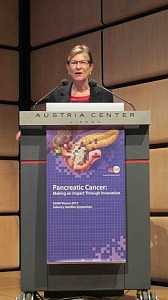Prospect of Abraxane in Pancreatic Cancer excites ESMO 2012
 One of the most interesting highlights of this ESMO for me has actually not been some new data or science that was presented here, but the sense of anticipation about the forthcoming nab-paclitaxel (Abraxane) data in pancreatic cancer.
One of the most interesting highlights of this ESMO for me has actually not been some new data or science that was presented here, but the sense of anticipation about the forthcoming nab-paclitaxel (Abraxane) data in pancreatic cancer.
The pancreatic cancer KOLs are a relatively dour group, much as melanoma specialists were until the advent of BRAF inhibitors. It’s largely a function of toiling away in a known graveyard zone with few effective therapies to offer patients and their families and then, suddenly, a new breakthrough is borne that re-energises the sub-specialty and propels it forward again.
I was therefore mildly surprised to find that the rare corporate symposia I attended on Friday afternoon was:
a) packed to the gills with standing room only and
b) the KOLs in an excited and feisty mood.
It was clear that something interesting was up.
Whilst it was made abundantly clear by the panel that the final data isn’t yet available, all of the KOLs presenting were at pains to say in their presentations it will be in “a few weeks” or “very soon” so thankfully we won’t have long to wait for the press release.
It is unlikely full details will be available until the data is presented at a major conference though, possibly ASCO GI, but we should at least have some indication whether it is positive or negative. After all, they sometimes do get a sense from their own patients whether one arm is doing better than the other or not, even if they don’t know until unblinding if it is a successful combination or a futile one.
The issue of futility is a real one i.e. did the patients on the treatment arm do worse than than the standard? We were vividly reminded of that today when Dr Dan Petrylak presented the phase III MAINSAIL data in castrate resistance prostate cancer, which demonstrated that patients receiving docetaxel and prednisone plus lenalidomide did worse than docetaxel and prednisone plus placebo. It is a risk and certainly can happen!
My assumption though, is that the nab-paclitaxel data is positive since a first cut of the analysis could be available by now, especially if the data will be announced soon. Why else would there be such warm enthusiasm from a well respected panel? Here are some examples of the sentiments expressed:
Dr Tempero: “We are on the verge of something exciting”
Dr Scheithauer: “The results are really good with nab-paclitaxel!”
Dr Ducreux: “The improvements in treatment of pancreatic cancer will come from new chemotherapies and combos.”
Dr Hidalgo: “The phase III (nab-paclitaxel) data will be available in a few weeks.”
Hidalgo discussed the role of SPARC in tumour growth and metastasis – it increases metastatic cell aggressiveness and is also involved in feedback loops involving angiogenesis see recent post on gemcitabine and nab-paclitaxel. SPARC expression can exist in both the stroma and the tumour. It has also be shown to correlate with improved overall survival and gemcitabine response. Reduction in SPARC by nab-paclitaxel leads to increased uptake by gemcitabine by removing the stromal barrier.
In concluding his presentation on the biology of pancreatic cancer, Dr Hidalgo emphasised the importance of targeting the stromal layer, which acts as a barrier protecting the pancreas and that “nab-paclitaxel appears effective.” Since one follows the other, the clues to what they all clearly knew were there.
You can read the Storify that Pieter Droppert of Biotech Strategy Blog collated from the live tweets of the session.
For those of you interested, I previously wrote about the preclinical evidence for nab-paclitaxel blasting through the stroma back at AACR in 2009. The scans from the animal models pre and post nab-paclitaxel were pretty impressive. You could instantly see the rationale for effectively blasting it out, thereby providing a haven for gemcitabine to work more effectively by increasing apoptosis and increasing tumour regression. It should be noted that while nab-paclitaxel has been shown to affect the stromal layer, whereas gemcitabine does not.
Hidalgo described how the combination of “nab-paclitaxel and gemcitabine shows interesting clinical and tissue effects” while showing some impressive PET scans of response. He went on to say that, “what I hope is the combination will be improved based on a median OS in the 10, 11 month range.”
In summary…
We’ll find out very soon whether the KOL expectations are correct, but if true, the combination of nab-paclitaxel and gemcitabine could potentially lead to a new standard of care. In turn, there are several impacts that will likely result from positive data:
1) It will provide a new chemotherapy doublet for future trials to be compared to. This will raise the bar in pancreatic cancer for new entrants including Threshold’s agent, TH–302, that is also attracting a lot of attention here at ESMO.
2) Positive news regarding doubling of overall survival will be particularly good for patients suffering from this terrible disease.
3 Responses to “Prospect of Abraxane in Pancreatic Cancer excites ESMO 2012”
It is worth noting that the hedgehog inhibitors had equally plausible “stroma busting” stories and preclinical data…and the clinical experience was much less exciting
Wow, this is a great blog, and also very interesting! We are so happy to hear that new developments in pancreatic cancer are being looked into. When do you think that more information with regards to these drugs and treatments will be released?
Wow, this is a great blog, and also very interesting! We are so happy to hear that new developments in pancreatic cancer are being looked into. When do you think that more information with regards to these drugs and treatments will be released?
Comments are closed.